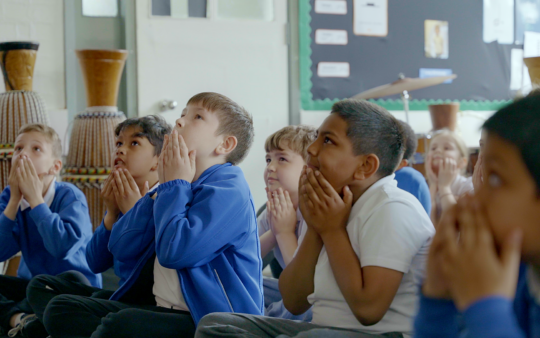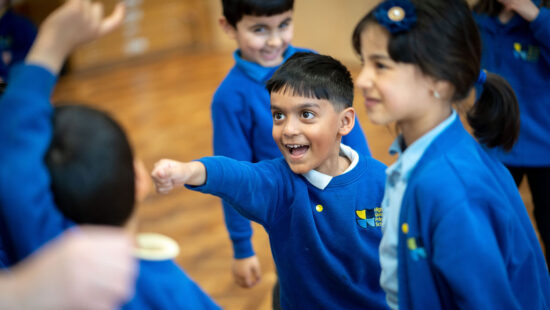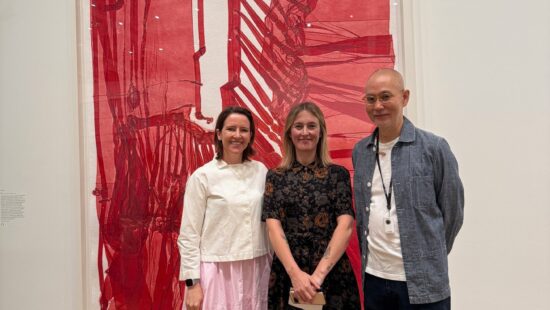What could the future of arts in schools look like?

What could the future of arts in schools look like?
Two members of Artis were invited to attend and speak at the Creative Young Bucks Conference. Sam Matthews (Oompah), Director of Artis Foundation and Louise Campbell (Zing) our School Partnerships Manager took to the stage to explore a big question: what could the future of arts in schools look like? Here’s a glimpse of their talk.
Why the arts in schools matter more than ever
Schools across the UK are dealing with a range of challenges: rising levels of anxiety and poor mental health among pupils, ongoing issues with attendance and disengagement, widening gaps in language, communication and oracy, and fewer opportunities for collaboration, creativity and play.
These issues not only affect individual learning outcomes but also signal deeper systemic problems within the education system.
The arts: Important but undervalued
The 2023 ‘Arts in Schools: Foundations for the Future’ report reinforced three key points. First, that arts subjects and experiences play a crucial role in improving outcomes for children and young people, equipping them with skills for both life and work.
Second, that despite this clear value, arts subjects remain undervalued in the state education system in England. And third, that while the challenges facing arts education mirror broader problems in education, the report makes clear that meaningful change is both necessary and achievable.
We see the difference creative learning makes, every single day.
Oracy
We know that in many schools, children are arriving with limited vocabulary and reduced confidence in speaking and listening. Recently, a Headteacher from one of our partner schools in Islington told us this:
“We’ve used Artis to support our literacy units this year, linking all sessions to writing outcomes. Our Specialist uses school planning to deliver creative drama sessions that promote oracy skills and include all children, regardless of need, experience or ability.”
“The sessions have improved children’s writing, but more than that, they’ve helped them express themselves creatively and emotionally. It’s had a real impact on how they communicate and understand the world around them.”
This is what creativity in education can look like: inclusive, empowering, transformative and a safe outlet for energy and emotion. And it doesn’t just support communication, it nurtures critical thinking, and the problem-solving skills young people need to navigate an unpredictable world.
Digital learning tools: friend or foe?
We are also growing and evolving at Artis. One of our newest innovations is Artis online; a digital platform offering weekly creative learning episodes enabling children to sing, dance and act the curriculum. It isn’t a replacement for our in-person sessions, but it is a powerful tool to extend our reach geographically, boost oracy, and bring creativity into every classroom.
A partner school near Halifax told us about a child who began the academic year with very limited vocabulary and found it extremely difficult to be around his peers. The teacher said;
“The child mostly worked in small groups and couldn’t verbally communicate his needs. He didn’t feel safe in the classroom with the rest of the class. But when we introduced Artis online, something changed. He began by watching from a distance. Then he joined in. Now, he’s part of the group.”
“His vocabulary has expanded, he’s using more words, and most importantly, he’s in class, with his peers, participating, communicating and belonging.”
This is what inclusion through creativity can look like. It’s not just about progress in arts, it’s about unlocking doors to language, confidence, and connection.
RAPS Study: The importance of arts richness
The Researching the Arts in Primary Schools study (which was the largest research of its kind in the UK) confirms all of this:
Arts rich education leads to better engagement, better learning, and a stronger sense of community.
It found that schools with a rich arts culture saw real gains, in civic participation, academic results, and student confidence.
So, what would define an arts rich school?
The results of the study showed important factors like:
- A curriculum that makes space for music, drama, dance, and visual art
- Specialist teachers or partners embedded in the school community
- Senior leaders who champion the arts and protect space for creativity
- Collaboration with arts organisations who bring the outside world in
- …And most of all, children who see themselves as confident and creative individuals
What could the future look like?
Indeed, many of the schools we work with serve communities where need is high, whether that’s SEN, EAL, or economic disadvantage. In those contexts, the arts become a lifeline, a language of expression, resilience, and connection.
And when you embed that into the life of a school? You see children thrive.
The outdated view that the arts are a ‘nice-to-have’ is crumbling. We now have both the stories and the statistics to prove that schools rich in creativity perform just as well if not better academically, and support more engaged, resilient learners.
So, I think the question isn’t, “Can we afford to invest in the arts?” It actually is: “Can we afford not to?”
Imagine a future where every child has access to creativity in school every week. Where the arts aren’t squeezed into end-of-term shows or one-off projects but embedded deeply into how we teach and learn.
Where creativity isn’t seen as “extra” but as essential.
How Artis fits in
These findings match what we’re doing at Artis:
- Our Creative Learning Specialists are exactly the kind of expert staff the study says make the difference.
- We support whole-school change, working closely with leadership teams.
- We embed the arts in ways that promote wellbeing, inclusion, and achievement.
- And we provide training and CPD, empowering classroom teachers to carry on the creative work independently.
Our work isn’t just visible in stories, it’s backed by data too.
A 2023 Pro Bono Economics study found that the Artis programme can generate:
- £2,300 in lifetime benefits per child, and
- Up to £8,700 for children with higher needs through improvements in attendance, mental health, future earnings, and more.
- Every £1 invested in Artis can return up to £32 in social value.
But beyond the numbers, we know we’re giving children the tools they need to thrive now and into the future.
Final thoughts
That future isn’t out of reach. In fact, in many schools we partner with, it’s already happening.
The arts aren’t seen a distraction from core priorities, they are a valued and powerful tool which helps to meet and enhance them.
For this vision to become reality, educators and artists must be supported by policymakers who understand the value of creativity as a driver of both personal and academic success.
We need bold investment, in funding, curriculum time, and training… to ensure the arts are embedded in every classroom, for every child.
As we have seen for many years – when creativity thrives children thrive.




